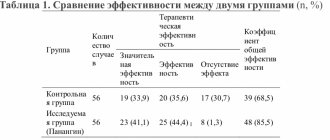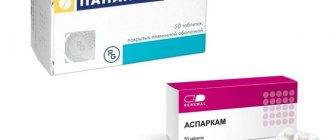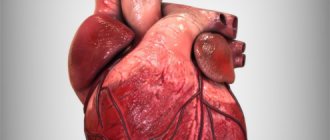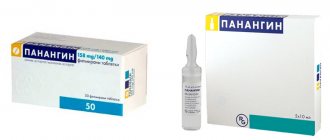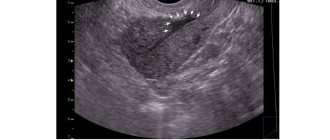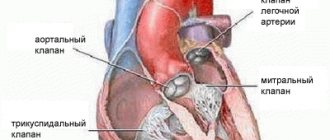Pregnancy is the most difficult period in a woman’s life, since the proper formation and development of the fetus directly depends on the health of the expectant mother.
Often, to maintain the body during pregnancy, the doctor prescribes vitamin-mineral complexes, or individual microelements necessary for the correction or prevention of certain conditions. We will talk about Panangin and its effect on a woman’s body during pregnancy in various trimesters.
special instructions
Due to the fact that the components of the drug are vulnerable to the aggressive environment of gastric juice and pancreatic enzymes, it is recommended to take Panangin simultaneously with food. This will ensure that the acidity of the stomach is reduced, and most of the enzymes will be occupied with the breakdown of fats and proteins contained in food, which will ensure that potassium and magnesium enter the intestinal lumen, from where the substances are absorbed into the blood.
Taking Panangin should be accompanied by regular blood tests so that the doctor can monitor the content of potassium and magnesium in the cells. This will avoid hyperkalemia and other negative consequences of overdose.
Panangin forte 60 pcs. film-coated tablets
pharmachologic effect
Potassium and magnesium preparation.
Composition and release form Panangin forte 60 pcs. film-coated tablets
Tablets - 1 tablet:
- Active ingredients: potassium aspartate 316.00 mg (in the form of potassium aspartate hemihydrate 332.60 mg), magnesium aspartate 280.00 mg (in the form of magnesium aspartate tetrahydrate 350.00 mg);
- Excipients: corn starch 172.20 mg, talc 20.00 mg, magnesium stearate 8.00 mg, potato starch 6.60 mg, povidone KZO 6.60 mg, colloidal silicon dioxide 4.00 mg;
- Tablet shell: talc 7.30 mg, butyl methacrylate copolymer 6.00 mg, titanium dioxide (color index: CI 77891, E171) 5.30 mg, macrogol-6000 1.40 mg.
15 tablets in a blister made of PVC/PVDC and aluminum foil. 2, 4, 6 blisters along with instructions for use are placed in a cardboard box.
Description of the dosage form
Oval, biconvex, film-coated tablets, white or almost white, with a slightly glossy surface, engraved “A83” on one side, almost odorless. On a cross section it is white or almost white in color.
Directions for use and doses
Before use, you should consult your doctor.
Take orally, without chewing and with plenty of water.
Panangin Forte should be taken after meals, because... the acidic environment of the stomach reduces its effectiveness.
Recommended daily dose: 1 tablet 3 times a day. Maximum daily dose: 1 tablet 3 times a day.
Pharmacodynamics
The most important intracellular cations of potassium (K+) and magnesium (Mg++) play a key role in the functioning of numerous enzymes, in the formation of bonds between macromolecules and intracellular structures and in the mechanism of muscle contractility. The intra- and extracellular ratio of potassium, calcium, sodium and magnesium ions affects myocardial contractility. Endogenous aspartate acts as a conductor of ions: it has a high affinity for cells, due to the slight dissociation of its salts, ions in the form of complex compounds penetrate into the cell. Magnesium aspartate and potassium aspartate improve myocardial metabolism.
Lack of magnesium/potassium predisposes to the development of arterial hypertension, atherosclerosis of the coronary arteries, arrhythmias and metabolic changes in the myocardium.
Each tablet of the drug Panangin Forte contains 280 mg of magnesium aspartate and 316 mg of potassium aspartate, which is 2 times higher than the content of active ingredients in the drug Panangin, film-coated tablets. The daily dose of the drug Panangin Forte: 1 tablet 3 times a day, corresponds to the daily dose of the drug Panangin: 2 tablets 3 times a day. Taking a single dose of Panangin Forte in the form of one tablet makes treatment more convenient for the patient.
Pharmacokinetics
Potassium and magnesium aspartates are intensively absorbed in the intestine, mainly in the small intestine. Excreted by the kidneys.
Indications for use Panangin forte 60 pcs. film-coated tablets
To eliminate potassium and magnesium deficiency as part of combination therapy for various manifestations of coronary heart disease (including acute myocardial infarction); chronic heart failure; heart rhythm disturbances (including arrhythmias caused by an overdose of cardiac glycosides).
Contraindications
Hypersensitivity to any of the constituent components of the drug, acute and chronic renal failure, hyperkalemia, hypermagnesemia, Addison's disease, atrioventricular block I-III degree, shock (including cardiogenic) (blood pressure less than 90 mm Hg), metabolic disorders amino acids, myasthenia gravis, hemolysis, acute metabolic acidosis, dehydration state, age under 18 years (efficacy and safety have not been established). Pregnancy (especially in the first trimester of pregnancy) and the period of breastfeeding.
Application of Panangin forte 60 pcs. film-coated tablets during pregnancy and breastfeeding
Use is possible if the potential benefit to the mother outweighs the possible risk to the fetus.
Potassium and magnesium aspartate pass into breast milk. If it is necessary to take the drug during breastfeeding, breastfeeding should be stopped.
special instructions
Patients with diseases accompanied by hyperkalemia require special attention: regular monitoring of potassium levels in the blood plasma is necessary.
Overdose
The risk of symptoms of hyperkalemia and hypermagnesemia increases.
Symptoms of hyperkalemia: increased fatigue, myasthenia gravis, paresthesia, confusion, cardiac arrhythmia (bradycardia, atrioventricular block, arrhythmias, cardiac arrest).
Symptoms of hypermagnesemia: decreased neuromuscular excitability, nausea, vomiting, lethargy, decreased blood pressure.
With a sharp increase in the content of magnesium ions in the blood: inhibition of deep tendon reflexes, respiratory paralysis, coma.
Treatment: symptomatic therapy - intravenous administration of calcium chloride at a dose of 100 mg/min, if necessary - hemodialysis.
Side effects Panangin forte 60 pcs. film-coated tablets
Possible nausea, vomiting, diarrhea, discomfort or burning sensation in the epigastric region (in patients with anacid gastritis or cholecystitis), atrioventricular block, paradoxical reaction (increased number of extrasystoles), hyperkalemia (nausea, vomiting, diarrhea, paresthesia), hypermagnesemia (redness of the face , feeling of thirst, decreased blood pressure, hyporeflexia, respiratory depression, convulsions).
If any of the side effects listed become serious, or you notice side effects not listed in this leaflet, you should consult your doctor.
Drug interactions
Pharmacodynamic interaction
When used together with potassium-sparing diuretics (triamterene, spironolactone), beta-blockers, cyclosporine, heparin, angiotensin-converting enzyme (ACE) inhibitors, and non-steroidal anti-inflammatory drugs, the risk of developing hyperkalemia up to the development of arrhythmia and asystole increases. The simultaneous use of potassium supplements with glucocorticosteroids eliminates the hypokalemia caused by the latter. Potassium reduces the undesirable effects of cardiac glycosides. Panangin Forte enhances the negative dromo- and bathmotropic effects of antiarrhythmic drugs. Magnesium reduces the effects of neomycin, polymyxin B, tetracycline and streptomycin. Anesthetics increase the inhibitory effect of magnesium preparations on the central nervous system; when used simultaneously with atracuronium, decamethonium, succinyl chloride and suxamethonium, neuromuscular blockade may be enhanced. Calcitriol increases the content of magnesium in the blood plasma, calcium supplements reduce the effects of magnesium supplements.
Pharmacokinetic interaction
Medicines that have an astringent and enveloping effect reduce the absorption of magnesium aspartate and potassium aspartate in the gastrointestinal tract, therefore it is necessary to maintain a three-hour interval between oral administration of Panangin Forte with the above medications.
Is it possible to combine Panangin and Riboxin?
It is necessary to combine medications with caution, having first consulted with your doctor. Riboxin, in addition to increasing cell metabolism and improving the absorption of drugs and other elements into the heart tissue, also enhances myocardial contraction. Taking them together can have a beneficial effect - potassium and magnesium best penetrate the fibers of the heart muscle. On the other hand, this may require adjustment of the dosage of Panangin to ensure that the required amounts of potassium and magnesium are not exceeded, in order to eliminate hyperkalemia.
Cost, instructions, contraindications Panangin
The drug Panangin is a source of electrolytes important for the functioning of the heart: magnesium and potassium ions. In addition, the drug affects metabolic processes.
Pharmacodynamics and pharmacokinetics of the drug
Panangin medicine contains two vital components - potassium and magnesium. Why does their deficiency in the body cause a lot of problems in the functioning of the heart? Let's take a closer look.
- Potassium . An important function of this element is that it maintains the membrane potential of myocytes, neurons and myocardial tissue structures. An imbalance between extracellular and intracellular potassium content can lead to a decrease in heart contractions, which, in turn, provokes arrhythmia and tachycardia.
- Magnesium . An important cofactor in most enzymatic reactions, in particular energy metabolism and nucleic acid synthesis. It has an important effect on the functioning of the heart: it reduces the tension of contractions, as well as the heart rate, helping to reduce the need for oxygen in myocardial tissue. The substance magnesium has a pronounced anti-ischemic effect on myocardial tissue.
The “potassium + magnesium” tandem in the drug Panangin reduces the toxicity of cardiac glycosides and does not affect their inotropic effect.
In addition, the combination of potassium and magnesium is based on the fact that a deficiency of one substance is often accompanied by a deficiency of the other, which develops diseases such as hypertension, atherosclerosis of the coronary arteries, and arrhythmias.
Therefore, simultaneous correction of the content of both elements is required.
Indications for use
The range of possible uses of the drug Panangin is very wide; let us consider in more detail in what situation and what health problems it helps:
- the drug is actively used for heart rhythm disturbances, which are caused mainly by electrolyte disturbances (or, more simply put, disturbances in the ionic composition) - a lack of potassium in the blood,
- the medicine is used for heart rhythm disturbances caused by intoxication with drugs from the medicinal plant digitalis,
- Panangin is effective for atrial rhythm disturbances (paroxysms of atrial fibrillation),
- the medicine is used for early disturbances in the rhythm of the heart ventricles (ventricular extrasystole),
- prescribe a drug for the treatment of coronary insufficiency (which in medical language means a discrepancy between the need for oxygen of the heart and the volume of its supply),
- Panangin is used to reduce hypoxic disorders of myocardial metabolism (lack of oxygen supply to heart tissue or impaired absorption),
- with a decrease in potassium in the blood, which is caused by the use of saluretic drugs (for example, diuretics, which increase the excretion of chlorine and sodium),
- with myocardial infarction,
- as replacement therapy for potassium or magnesium deficiency in foods.
Contraindications
The drug is not indicated for all patients; there are diseases for which the use of this medicine is contraindicated:
- hyperkalemia (content of potassium in the blood above the established norm),
- hypermagnesemia (magnesium content in the blood above the established norm),
- cardiogenic shock,
- severe form of myasthenia,
- violation of amino acid metabolism,
- acute form of metabolic acidosis,
- hemolysis, dehydration,
- insufficient function of the adrenal cortex,
- hypersensitivity to the components of the drug,
- lack of water in the body (dehydration).
Use with caution:
- in the 1st trimester of pregnancy,
- with sensitive and severe liver dysfunction,
- with a possible risk of varying degrees of edema,
- with hypophosphatemia,
- with metabolic acidosis,
- with urolithiasis, which is associated with impaired calcium and magnesium metabolism.
Mode of application
Panangin is prescribed using the following dosage:
- the classic norm according to the instructions is 1-2 tablets per day,
- severe cases (intolerance to digitalis, coronary circulation disorders) - 3 tablets 3 times a day, and after 5-7 days the dose is reduced to 1 tablet 2 times a day.
The tableted drug is taken after meals.
To relieve (stop) attacks of arrhythmia, the drug solution is administered slowly intravenously; for this, the contents of the ampoule must be diluted with an isotonic solution of glucose or sodium chloride.
Overdose and symptom management
Cases of overdose with Panangin have not been reported to date. However, there is a possibility of symptoms of hypermagnesemia and hyperkalemia, that is, an oversaturation of potassium and magnesium preparations in the blood.
Symptoms of hyperkalemia:
- myasthenia gravis,
- rapid and prolonged fatigue,
- paresthesia,
- disorders of the heart (arrhythmia, bradycardia, rarely - cardiac arrest),
- confusion.
Please note: Amlodipine has side effects. What are the side effects of the drug and what should you do about them?
In the news (link) there are analogues for Tricardin.
Symptoms of hypermagnesemia:
- vomiting (urge),
- Sopor,
- decrease in blood pressure,
- respiratory paralysis, coma,
- with a sharp increase in the concentration of magnesium in the blood, deep tendon reflexes can be inhibited.
Treatment of an overdose of Panangin consists of discontinuing the drug or eliminating symptoms by administering calcium chloride intravenously. In severe cases, hemodialysis is prescribed.
Interaction with other drugs
If taking other medications, the patient must notify his doctor about this in order to establish the possibility of combined treatment with Panangin. Let's consider the interaction of this medicine with others.
- The drug can significantly inhibit the absorption of tetracycline and iron salts, as well as sodium fluoride. It is recommended to wait at least 3 hours between taking these medications.
- Simultaneous use of ACE inhibitors or potassium-sparing diuretics (Triamterene, Spironolactone) increases the risk of developing hyperkalemia, therefore potassium in the blood plasma should be monitored.
- Under the influence of potassium contained in Panangin, the side effects of cardiac glycosides are reduced.
- Anesthetic drugs increase the inhibition of magnesium drugs in the central nervous system.
- Parallel use of Panangin and the drugs Atracuronium, Decamethonium, Succinyl chloride, Suxamethonium can provoke increased neuromuscular blockade.
- The drug Calcitriol increases the magnesium content in the blood.
Price
The price of the drug in question varies within the following limits:
- in Russia - from 128 to 139 rubles,
- in Ukraine - from 38 to 43 hryvnia.
Analogs
The most popular analogue of Panangin is Asparkam. This is a time-tested medicine - it has been produced for several decades.
This drug is domestically produced, its composition is completely similar to that of Panangin, while the price of Asparkam is several times lower.
The main indicator of these drugs is their effectiveness, and reviews of patients who have used both drugs indicate the high effectiveness of Panangin.
The difference between Panangin and Asparkam is that Panangin is available in dragees, and Asparkam is available in tablets.
The dragee is covered with a protective coating, so for colitis, enterocolitis, stomach diseases, and ulcers, it is better to take Panangin to protect against the active ingredient.
The main difference between these medicines is that Panangin is the original, and Asparkam is an analogue, so its effect is somewhat weaker.
This medicine is a complete analogue of Panangin in composition, indications, contraindications and side effects. It is available in the form of dragees, solutions for injection and for intramuscular administration, however, the effectiveness of use is somewhat weaker and less pronounced than that of Panangin.
Reviews
Reviews about the use of this medicine are only positive; patients note an improvement in the condition and functioning of the cardiac system. Let's look at the most popular reviews.
Read further - indications for use of Nebilet. When should you take the drug?
In the article (tyts) the price of Felodip.
Natalya Ivanovna, 38 years old.
“According to the indications, I was prescribed the use of a diuretic drug and Asparkam along with it. Having gone to the pharmacy, they gave me a diuretic, and instead of Asparkam they recommended Panangin, since Asparkam was not available at that time. After studying the instructions, I began to take this, I must say, expensive remedy.
To my surprise, the problems of shortness of breath, aching pain in the heart area, and fatigue disappeared. I told my doctor about this and he really confirmed the high degree of effectiveness of Panangin, but only noted its high cost. "
Alexey Petrovich, 64 years old.
“Recently, I was on vacation at a sanatorium, where I was prescribed Panangin as a prophylactic agent, explaining that it is a good prevention of heart disease (it was with these problems that I went to the sanatorium).
Immediately I did not attach importance to my good mood and well-being, but when I arrived home and stopped taking Panangin, after a while I felt unwell and heaviness in the heart area.
I consulted with my doctor - he recommended that I take this medicine constantly, now I feel good and recommend this amazing remedy to all my friends and acquaintances. "
Marina, 28 years old.
“Since childhood, I have had problems with the cardiovascular system - I am excreted in large quantities of the elements necessary for the functioning of the heart, so I constantly need to replenish them. Doctors recommended me products with a high content of essential substances, but such help was short-term.
Then one of the doctors prescribed Panangin for me - after a week of taking it, I seemed to come to life, because the depressing fatigue, constant feeling of lack of sleep, and weakness disappeared. I highly recommend this effective drug."
Was the article helpful? Perhaps this information will help your friends! Please click on one of the buttons:
Panangin: what to replace during pregnancy?
Panangin is considered the most effective drug for pregnant women, which contains a bioavailable form of magnesium and potassium. And the presence of the shell allows cations to be delivered to the stomach without destroying them under the influence of acids.
This drug has only one analogue - Asparkam. The composition of these two products is identical, but in Panangin the minerals are in a shell, while in Asparkami they are in a simple white tablet without a film coating.
For women during pregnancy with a healthy digestive tract, which of these two drugs to take does not matter much. However, if you have a peptic ulcer or enterocolitis, it is advisable to choose Panangin.
Panangin during pregnancy: reviews
Pregnant women on the forums confirm that they mostly have such appointments in the 2nd and 3rd trimester. Many expectant mothers are worried and ask advice from those who were prescribed Panangin during pregnancy: should they take it or not?
The experience of other women indicates that the medicine is well tolerated during pregnancy, acts quickly and effectively: it becomes easier to breathe, the heart calms down, the mood improves and sleep improves, swelling decreases and cramps disappear.
Most of them are satisfied with the effect of Panangin tablets. But, of course, they are not suitable for everyone. Some people do not notice any effect, while others feel better if they take only magnesium separately.
All this once again confirms that different conditions require different therapy. But only a specialist can competently understand the issue.
